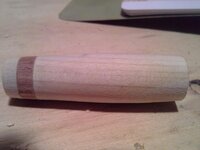Hi peoples,
I was reading this thread from the very beginning and I was looking for any "guesses" that could take the problem to something that some new people to turning and to the various woods characteristics and grains visual effect, often gets caught as something unfamiliar and therefore a fault or a problem.
What I'm talking about is the curl/fiddleback/and other waving effects present in some woods, this is not a joke nor indicates any silliness from the new turner part, is simple something that people with little or no knowledge and or experience with "woods", can easily be taken for.
I remember at least twice I read in various forums I have been a member of through the years, of someone thinking that they pen barrels have "chatter" as they called it while the visual effect was what made them believe, there was a problem that they didn't understand.
What for some of us, is simple to understand and work out, can be not so easy for someone just starting using/wrking materials that they are not familiar with, that is more common that what some people may want to believe, but is a true fact.
I'm not claiming that, this is the case here but, those reading this thread that are in the "beginners category" can learn something from this and or become aware of its possibility...! :wink::biggrin:
Cheers
George

